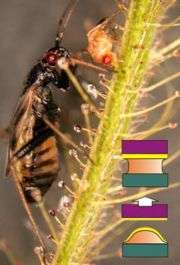Nothing stops an expert in the art of living

There are few things more irritating than a fly buzzing around the house. South African's have an unconventional solution to the problem. They hang up a bunch of Roridula gorgonias leaves. Attracted to the shiny adhesive droplets on the leaf's hairs, the hapless pest is soon trapped by the natural flypaper.
However, this is not the end of the story. Each R. gorgonias plant is home to a population of Pameridea roridulae (mirid bugs), which dine on the trapped insects. Yet the mirid bugs successfully evade their host's sticky clutches. Curious to find out how, Dagmar Voigt and Stanislav Gorb from the Max-Planck Institute for Metals Research, Germany, decided to take a look at the apparently non-stick bugs to see how they elude R. gorgonias' grasp. (Journal of Experimental Biology, August 8th, 2008)
The team needed to get their hands on Roridula gorgonias plants, complete with their own private mirid bug colonies, and that so far from the plant's home in South Africa. 'Fortunately there are a few R. gorgonias enthusiasts in Germany' says Voigt, and after contacting Klaus Keller in Augsburg, he agreed to supply the team with the hairy plants and their residents.
Back in their Stuttgart lab, Voigt and Gorb decided to test how non-stick mirid bugs really are. Wrapping a bug in a leaf the team were amazed when they unrolled it and 'the bug jumped up and ran away!' says Voigt. The bug was completely non-stick. Next, the team checked the mirid bug's surface by pressing a bug against a glass slide and looked at the slide under a microscope to see if they were covered in a special glue-proof coating. The bugs seemed to be coated in a greasy fluid. Voigt explains that all bugs are covered in a greasy layer, so what made the mirid bug's surface more non-stick than other insect coatings?
Flash freezing the bugs to -120°C, Voigt and Gorb looked at the insect's coating at high-resolution with a cryo scanning electron microscope (cryo-SEM). The mirid bugs coating was 30 times thicker than the blowfly they compared it with. But how was this extra thick coating protecting the mirid bugs? Did it come loose when contacted by adhesive? Or was the greasy coating somehow disrupting the glue's adhesive powers?
Touching a sticky hair against a piece of mirid bug cuticle and looking at it with cryo-SEM, the team could see that the glue seemed to run like a fluid over the thick greasy surface. However when they looked at a R. gorgonias hair in contact with a section of blowfly cuticle, the glue formed a discrete mass that looked like a gel with well-defined edges. The mirid bug's greasy coating appeared to disrupt the glue in some way, preventing it from adhering to the insect's surface.
Finally the researchers measured how strongly the glue became attached to various insects' surfaces. Having removed the mirid bug's protective layer by washing in cold chloroform, the team found that the glue stuck as strongly to the mirid bugs as other insects, with the glue stretching to produce filaments as much as 5 cm long. But when they successfully attached glue droplets to unwashed mirid bug cuticles, the cuticles easily broke free of the glue, rarely forming filaments more than 1.5 cm long. Voigt suspects that insect victims eventually exhaust themselves, fighting against the adhesive filaments.
Voigt and Gorb are keen to understand more about the mechanism that keeps Pameridea roridulae roaming free, while other insects succumb to the glue that mirid bugs simply shrug off.
Citation: Voigt, D. and Gorb, S. An insect trap as habitat: cohesion-failure mechanism prevents adhesion of Pameridea roridula bugs to the sticky surface of the plant Roridula gorgonias; Journal of Experimental Biology 211: 2647-2657, doi:10.1242/jeb.019273
Source: Max-Planck-Gesellschaft

















